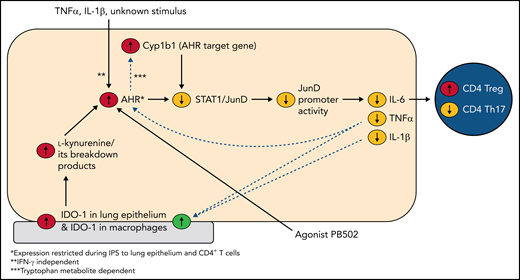In this issue of Blood, Lee et al identified aryl hydrocarbon receptor (AHR) to be a critical inflammation checkpoint in lung epithelium, mediating suppression of AP-1 gene expression and reducing the severity of idiopathic pneumonia syndrome (IPS) after experimental allogeneic (allo) hematopoietic cell transplantation (HCT).1
For decades, IPS has been recognized as one of the most detrimental complications after allo-HCT, rapidly leading to respiratory failure and death despite the advances in supportive care. The incidence of IPS has decreased owing to the reduced toxicity of HCT conditioning regimens, but when IPS does occur, outcomes remain poor. In IPS, the lung becomes the target of a multipronged attack involving alloreactive T lymphocytes, monocytes/macrophages, inflammatory cytokines and chemokines.2-4 The use of tumor necrosis factor α (TNFα) blockade or interleukin 6 (IL-6) neutralization with high-dose corticosteroids has improved outcomes in some but not all patients.5 Hence, a better understanding of IPS pathophysiology and identification of preventable targets and novel treatments are urgently needed.
Shedding more light on the underlying molecular pathways of IPS, Lee et al elegantly demonstrate how increased lung epithelial AHR expression reduces JunD promoter activity, leading to decreased IL-6 levels and thereby decreased differentiation of donor T helper 17 (Th17) cells in the lung, while increasing CD4 regulatory T cells (see figure). Deficiency of AHR in nonhematopoietic cells of the recipient resulted in worsened IPS along with increased Th17 cells and decreased regulatory T cells. Furthermore, L-kynurenine amelioration of lung injury occurred only in the presence of AHR, confirming that AHR is targetable and able to suppress inflammation. Leveraging their newly gained knowledge, the authors then developed PB502, a selective and more potent direct AHR activator. Administration of PB502 resulted in reduced severity of IPS and intestinal graft-versus-host disease and improved overall survival more efficiently than kynurenine.1
Schematic diagram of AHR as a key regulator in lung epithelial cells during experimental idiopathic pneumonia syndrome. IDO-1, indoleamine 2,3-dioxygenase 1; IFN-γ, interferon γ.
Schematic diagram of AHR as a key regulator in lung epithelial cells during experimental idiopathic pneumonia syndrome. IDO-1, indoleamine 2,3-dioxygenase 1; IFN-γ, interferon γ.
These findings illuminate a concept of “healthy inflammation,” wherein an early inflammatory response activates immune checkpoints, which upon prolonged stimulation by same or similar inflammatory mediators downregulate the inflammatory process: AHR expression early after conditioning was increased in lungs of allo-recipients, suggesting that early AHR expression is potentially initiated by an overwhelming early cytokine storm observed in these models.6 During the course of the disease, AHR expression leads to decreased TNFα and IL-1β levels, yet those cytokines continue to stimulate AHR expression until inflammation is resolved. Exogenous induction of AHR by PB502 therefore presents an intriguing approach to accelerate and augment the suppressive efficacy of AHR on inflammatory cytokine production, the decreased generation of Th17 T cells, and a shift to an increase of regulatory T cells in the lung (see figure).
Although AHR expression may be beneficial for epithelial barrier function and lung health in some models, it may be injurious in others. AHR-deficient mice show enhanced repair of lung bronchial epithelial cells.7 Interferon-β/γ induction of AHR in lung epithelial cells increased mucus production and hypoxia in severe acute respiratory syndrome coronavirus 2–induced lung disease,8 yet AHR signaling protects from mucus production in an asthma model.9 Finally, AHR activation during development enhanced pulmonary CD4+ T-cell responses in the adult.10 Taken together, these studies demonstrate the multifaceted roles AHR can have depending on the model and the context and underscore the need for further studies to understand how AHR signaling affects epithelial barrier function and regenerative potential in IPS.
In summary, Lee et al’s report on the role on AHR signaling in experimental IPS provides insight into mucosal barrier checkpoint control of inflammation on a very granular level, that will inevitably excite both scientists and clinicians striving to better understand not only allo-HCT–related complications but also inflammation regulation in general.
Conflict-of-interest disclosure: The author declares no competing financial interests.


This feature is available to Subscribers Only
Sign In or Create an Account Close Modal